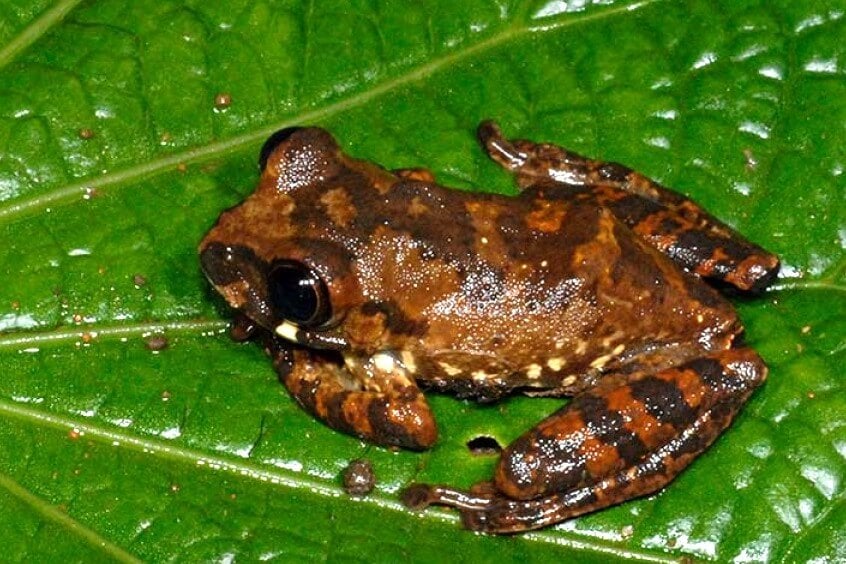For the past few years, how a virus triggered a global pandemic has dominated conversations.
Now, thanks to the TV show “The Last of Us” (about an apocalypse triggered by brain-eating ’shrooms), fungi have infected popular culture. The focus has been on pathogens that cause human disease, but what about those affecting nonhuman species? San Francisco State University scientists are among the many concerned about a fungus that has been detrimental for amphibians worldwide and is contributing to a loss of biodiversity.
In a new Frontiers in Conservation Science paper, San Francisco State researchers detail the relatively recent emergence and spread of a deadly fungus (Batrachochytrium dendrobatidis or Bd) among amphibians in Africa. Eight of the co-authors are former SF State students who were in a seminar class led by senior investigator Vance Vredenburg, a University Biology professor.
“When [amphibian] skin starts to change thickness, it basically creates a condition where they can’t maintain their internal processes and they die,” said co-author Eliseo Parra (B.S., ’14; M.S., ’17) about how the fungus attacks. “If infecting a mammal, it might affect your fingernails or something you wouldn’t even notice, but amphibians (frogs, salamanders) use their skin to breathe. It’s a very critical part of their body.”
The fungus is lethal for many amphibian populations but not others, Vredenburg says. His lab wanted to understand where the fungus is, how it got there and why it’s deadly for some amphibians, particularly in Africa where it has been under-studied.
In 2016, Vredenburg’s class, eager to get involved in conservation research, read papers about Bd and evaluated previously published data. In parallel, Vredenburg’s lab, in collaboration with the California Academy of Sciences, assessed the infection status of amphibian specimens from Africa. These two approaches gave the project nearly 17,000 records for analysis and a 165-year view of how this fungus interacts with amphibians across the continent.
The team reports low Bd prevalence and limited spread of the disease in Africa until 2000, when the prevalence increased from 3.2% to 18.7% and Bd became more widespread geographically. Vredenburg notes that not only is the fungus infecting amphibians but it is causing negative (often deadly) consequences versus being dormant.
The researchers also found two lineages of the fungus in Africa. One was a global lineage — considered the most dangerous version of the fungus — while the second was previously believed to be more benign, though the SF State team found evidence that it may also be destructive. Using their data, the team created a model that predicts that eastern, central and western Africa are the most vulnerable to Bd.
“We’re trying to extend our findings and make predictions about what could happen in the future. It’s the best way to make our study worth the work,” Vredenburg said. “There are nearly 1,200 amphibian species in Africa. We wanted to say where are the riskiest places for outbreaks. Those will probably be the places where you have the most hosts in one place.”
“It’s very important to note that Bd didn’t spread worldwide without humans helping in one way or another,” added co-author Hasan Sulaeman (B.S., ’16; M.S., ’19). “It’s not the first pathogen that affects hundreds of species worldwide and it’s not going to be the last.”
The team points out that this project does not fit the traditional molds for science research papers or literature reviews. The fact that a scientific paper resulted from research done in a class is rare too, Vredenburg explains, attributing the feat to students’ talent and motivation.
Both Parra and Sulaeman participated in the project as students in the seminar class and as researchers in Vredenburg’s lab. They are among the students who continued to be involved for some part of the five years after the initial semester-long project. Through this experience, they gained valuable insight into the scientific publication process — something that is not trivial or quick — early in their careers.
Sulaeman is currently working on CDC-funded national SARS-CoV-2 studies, while Parra studies animal behavior in rainforests as a Ph.D. student at UCLA. Both alums recall the research environment that Vredenburg fostered that brought together undergraduate and graduate students with a variety of cultural and scientific backgrounds and levels of expertise. They both note the power in diversity and how it improves science.
“When you have a lot of really smart people in a room sitting at a table regularly, it is possible to do a lot. Maybe we didn’t understand that at the time or maybe this was a big lesson for us [students],” Parra said. “But Vance definitely knew that you could actually walk away from a class with an important piece of published research.”

